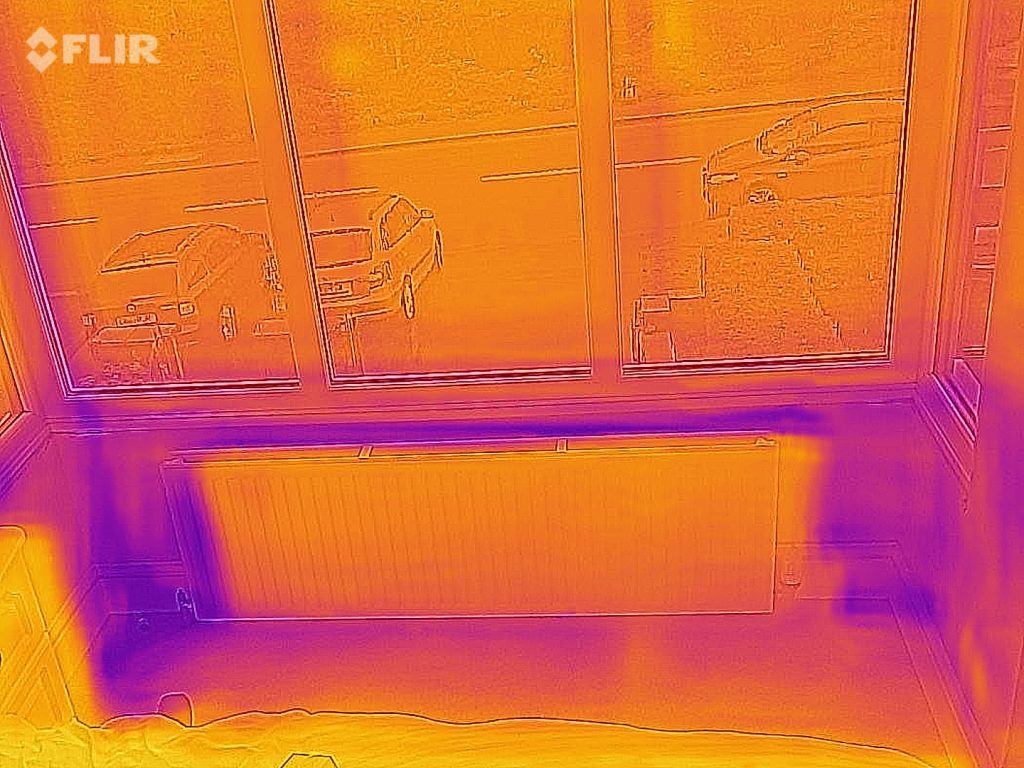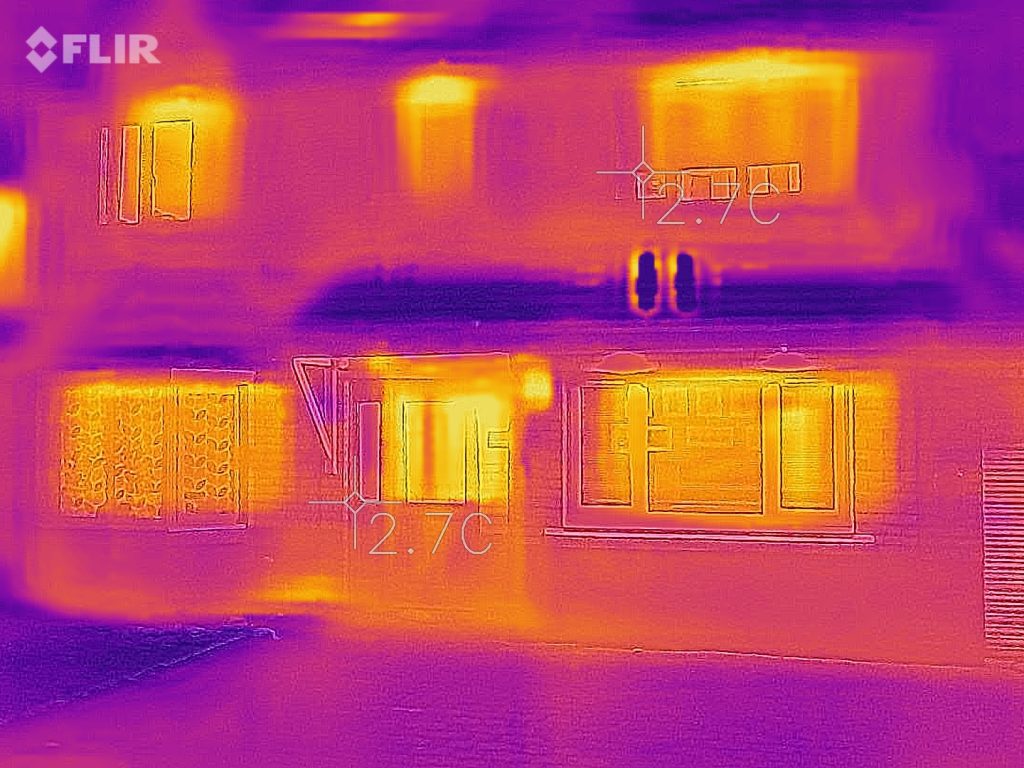FLIR Thermal Camera
I was lucky enough to be loaned a FLIR thermal camera by Octopus Energy. I had the camera for a week and below you can find a summary of my experience with it.
But before we explore the camera, let’s take a step back and think about what we problems we are looking for in our houses.
Why insulation matters
The amount and level of insulation inside and outside your house directly correlates to the amount of energy required to heat your home.
- More insulation – less heat and energy required
- Less insulation – more heat and energy required
If we can reduce the demand for energy and burn less fuel we can
- a) save money
- b) combat climate change
Around three-quarters of all the energy you use in your home goes towards space-heating and hot water. So if we can reduce the amount of energy required to heat your home it can have a big impact on your annual bill.
Lets see if we can put some ballpark figures around some of this then.
The average size of a house in the UK is 76 square metres.
This article from OVO Energy suggests that new builds in the UK use 100kWh of energy per square metre each year.
So an average new UK property uses 76 x 100kWh = 7600kWh per year for heating.
Note: these figures probably don’t take into account Coronavirus where many people have been working from home through the winter and as such, have a higher energy demand during this period.
The OVO article goes on to explain how annual demand figures change depending on the level of insulation in the property as demonstrated by this table.
| Type of House / Insulation Quality | Annual heating demand |
| Leaky | 300 kWh/m2 |
| Old | 200 kWh/m2 |
| Modern | 150 kWh/m2 |
| New | 100 kWh/m2 |
| Low | 50 kWh/m2 |
| Passive | 15 kWh/m2 |
So a new build needs 100 kWh per square metre to heat the house, but a bit of an older, less efficient house may need double that amount of energy.
What does this look like in monetary terms?
I’m going to pluck a figure out of the air of 3.5p/kWh for each energy unit.
This is around the current Gas price (early 2021) and if your heat pump gets a COP (coefficient of performance) of 3, that makes electricity 10.5p per unit, which you can achieve on Agile.
UPDATE: Late 2022 sees gas close to 15p per unit and electricity 45p per unit. So bear that in mind with these original calculations from early 2021.
Once again, your usage may vary as well as the pricing of your particular energy tariff. These figures attempt to just tell the story about the ‘average UK 76 square metre house’.
Annual Cost chart
| House Type | KWh per sqm | Annual Demand (kWh) | Annual Cost |
| Leaky | 300 | 22800 | £798.00 |
| Old | 200 | 15200 | £532.00 |
| Modern | 150 | 11400 | £399.00 |
| New | 100 | 7600 | £266.00 |
| Low | 50 | 3800 | £133.00 |
| Passive | 10 | 760 | £26.60 |
As you can see from the table above, as you increase the insulation capabilities within the property the energy demand required to heat the home decreases and as such, the annual cost comes down too.
So that is the goal, improve the thermal efficiency of your house to lower your energy demand, lower your bills and lower your carbon footprint.
If you’re interested in reading and listening to more about insulation then Carbon-Coop website is a great place to start. They have a bunch of really helpful videos, especially this one by Nick Parsons.
https://carbon.coop/carbon-co-op-webinar-programme/#deep-retrofit-fundmentals
I can personally vouch for Nick Parsons at Sustainable Buildings as he did a home survey for me this summer. A very knowledgeable chap.
You can contact him via: http://syec.co.uk/sustainable/
So after all the preamble and foundational information, how can one of these FLIR cameras help me and where can I get one?
What does a FLIR camera do?
A thermal camera is a non-contact device that detects infrared energy (heat) and converts it into a visual image.
You can read more about the science behind it all on the FLIR website.
As you can see from this image, hot things are shown in very light colours and cold things in dark colours.

Where can I get a thermal camera from?
Well you could buy one. They are about £200 – £400 depending on which model you go for. If you’re planning a lot of renovation work or maybe an insulation retrofit then it may be a worthwhile investment to buy one.
Alternatively, if you are an Octopus Energy customer then they will loan you one for a week for FREE. You just need to add your name to the waiting list.
Note: This camera loan program only runs through the winter months as it’s much easier to spot the thermal differences when it’s warmer inside (with the heating on) and colder outside. You wouldn’t spot a great deal of difference during the summer.
You can find more information via the Octopus Energy website.
https://octopus.energy/blog/flir-thermal-cameras/
The small FLIR unit has its own cameras and simply attaches to the your phone as shown here. This is the iOS version for iPhone, but there is also an Android version.
You then use the FLIR One App available from the Apple App Store or from Google Play and any thermal images snapped are saved to your phone.
So even after you return the FLIR camera back to Octopus you’ll still have the photos on your phone.

How can the camera help?
Quite simply, you wander around your house pointing the camera at things. If you see really dark spots in your house this would suggest there is cold getting in.
Maybe it’s a draught? If you can feel a draught coming in, then that is an opportunity for heat to also get out.
Maybe the insulation in a room could be improved?
Lets look at a very simple example.
Here is a Velux window in our house. On the left photo the blind is up with the window pane exposed. Then on the right, the same window has had the blind closed to cover up the window.

As you can instantly see, there is a marked difference in the cold coming into the room through the window. So to keep the warmth in and the cold out, close any curtains or blind in front of windows.
Making your house more energy efficient isn’t always about spending tons of money on expensive projects. Using binds, curtains and draught excluders can be very impactful.
Here is another example that I found in the house. I noticed there were draughts coming from the surrounds of this window where the internal seal had cracked. You could feel a draught with your fingers. So a very cheap tube of decorators caulk later and the draught had gone.
Granted, on its own this may only seem like a small win, but if you can find lots of these then they can all add up.

Octopus Energy themselves also show a wide variety of easy fixes on their blog page; doors, windows, loft hatches, unused rooms etc.
https://octopus.energy/blog/flir-thermal-cameras/
Even if it’s taking a while for you to get to the top of the thermal camera waiting list (or the program has suspended for the summer) you could easily start looking for these small problems around your home now without a camera.
The Energy Savings Trust has a great page on their website containing helpful draught proofing advice.
https://energysavingtrust.org.uk/advice/draught-proofing/
Bigger Problems
But there are some things you find that may need some investment to sort out. In our case, the front upper bay window. As you can see from this photo, there is ZERO insulation here.


It appears to be just tiles on the outside and plasterboard on the inside with NOTHING in-between.
So this is something that we will need to address to stop leaking heat and wasting energy.
Cavity Wall Insulation
One major thing a thermal camera can highlight is cavity wall insulation or the lack of it.
Here are some before and after photos from energy-stats follower Grahame.
The FLIR camera showed his house was leaking heat and energy at an alarming rate. You can see all the yellow and white parts on the photos.
Here are some photos showing both before and after Grahame had their cavity wall insulation installed.




Here’s a summary of the work that Grahame had done in his own words.
The house was treated with EPS Polystyrene Beads which were installed through holes drilled in the mortar, they are injected along with an adhesive to bond them together in place, reducing air movement in the cavity and trapping warmth.
The insulation cost £1,700 to do (large 4 Bedroom Detached) but there are grants available in certain areas.
We’ve noticed a big improvement in comfort as the house retains it’s warmth better now.
We hope to see reductions in our heating bills over the years too.
Green Homes Grants
As Grahame mentioned above, you could be eligible for grants.
Green Homes Grants vouchers will cover two-thirds of the cost of eligible improvements, up to a maximum government contribution of £5,000.
You can put these towards the cost of installing energy efficient improvements to your home.
Improvements could include insulating your home to reduce your energy use or installing low-carbon heating to lower the amount of carbon dioxide your home produces.
You must redeem the voucher and ensure improvements are completed by 31 March 2022.
Full details are available via the government Green Home Grants website: https://www.gov.uk/guidance/apply-for-the-green-homes-grant-scheme
Community and people-powered cooperatives like Carbon-Coop would also be great service contact for help with the likes of the Green Homes Grant: https://carbon.coop/
If you find this information useful and are thinking of joining Octopus Energy, please consider using my referral code or ‘buy me a coffee’ to help support running costs of the website.
Using this referral code will gift you £50 of free credit after signup:
https://mickwall.octopus.energy
We can also be found on Twitter, please follow us @energystatsuk for daily Agile tariff pricing graphs and summaries.
Also, be sure to check out our Dashboard, Download Historical Data and OctoChargeCalc features to help you decide whether these tariffs are the right fit for you.
Note: The past performance of energy pricing is not necessarily a guide to the future.
